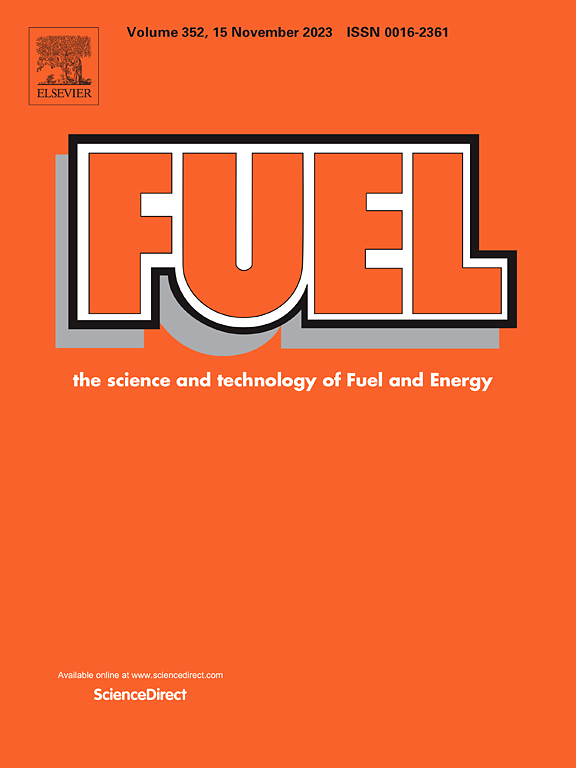通过单颗粒电感耦合等离子体质谱(spICP-MS)分析用作重质原油原位升级沉淀剂的纳米颗粒的特性
IF 6.7
1区 工程技术
Q2 ENERGY & FUELS
引用次数: 0
摘要
使用单颗粒电感耦合等离子体质谱法(spICP-MS)对碳氢化合物基质中的纳米颗粒(NPs)进行表征的技术还不够成熟。在碳氢化合物基质中使用 spICP-MS 的文献不到十篇,而且没有一篇应用该技术来测定通过溶剂脱沥青对重油进行原位升级后沥青质中的 NP 浓度和粒度分布。据我们所知,还没有研究使用 spICP-MS 在不掺杂样品的情况下跟踪碳氢化合物沥青质馏分中 NP 添加剂的性质。本文首次报道了通过 spICP-MS 得出的碳氢化合物基质中的粒子数浓度(PNC)。与不含添加剂的样品相比,Fe2O3 的粒子数浓度增加了一个数量级,NiO 的粒子数浓度增加了 28%,这表明 NPs 在沥青质中的分散程度相当好。镍的离子浓度高于铁,而铁在所有样品中的变化可以忽略不计。在此,我们报告了在碳氢化合物基质中使用 spICP-MS 检测 Fe2O3 NPs 的最低尺寸检测限(32 nm ± 1 nm)。此外,NiO 和 Fe2O3 NP 的尺寸与沉淀前添加到油中的初始尺寸一致,这证明了 NP 的性质在脱沥青和随后与沥青质混合后不会发生变化。这项研究拓展了我们对重质原油原位升级过程中金属 NPs 与沥青质作为共沉淀剂时的相互作用的理解。本文章由计算机程序翻译,如有差异,请以英文原文为准。
Characterization of nanoparticles used as precipitant agents for in situ upgrading of heavy crude oils via single particle inductively coupled plasma mass spectrometry (spICP-MS)
The characterization of nanoparticles (NPs) in hydrocarbon matrices using single particle inductively coupled plasma mass spectrometry (spICP-MS) is underdeveloped. There are less than ten publications using spICP-MS in hydrocarbon matrices, and none have applied the technique to determine NP concentration and size distribution in asphaltenes after in-situ upgrading of heavy oils via solvent deasphalting. To our knowledge, no studies have used spICP-MS to track the nature of NP additives in the asphaltene fraction in hydrocarbons without adulteration of the sample. Particle number concentrations (PNC) derived from spICP-MS in hydrocarbon matrices are reported for the first time. Fe2O3 PNC increased by an order of magnitude, and NiO PNC increased 28 % compared to samples without additives, indicating that NPs were reasonably well-dispersed in the asphaltenes. Ionic concentrations were higher for Ni than Fe, which showed negligible changes in all samples. Here, we report the lowest size detection limits recorded for Fe2O3 NPs (32 nm ± 1 nm) using spICP-MS in hydrocarbon matrices. Further, NiO and Fe2O3 NP sizes matched the initial sizes added to the oil before precipitation, providing evidence that the nature of the NPs does not change after deasphaltation and subsequent mixing with asphaltenes. This study expands our understanding of the interactions between metal NPs and asphaltenes when used as co-precipitants during in situ upgrading of heavy crude oil.
求助全文
通过发布文献求助,成功后即可免费获取论文全文。
去求助
来源期刊

Fuel
工程技术-工程:化工
CiteScore
12.80
自引率
20.30%
发文量
3506
审稿时长
64 days
期刊介绍:
The exploration of energy sources remains a critical matter of study. For the past nine decades, fuel has consistently held the forefront in primary research efforts within the field of energy science. This area of investigation encompasses a wide range of subjects, with a particular emphasis on emerging concerns like environmental factors and pollution.
 求助内容:
求助内容: 应助结果提醒方式:
应助结果提醒方式:


